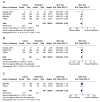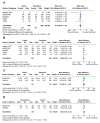Transfusion Thresholds and Neurological Functional Outcome After Acute Brain Injury: An Updated Systematic Review and Meta-Analysis of Randomized Clinical Trials
- PMID: 40429483
- PMCID: PMC12112058
- DOI: 10.3390/jcm14103487
Transfusion Thresholds and Neurological Functional Outcome After Acute Brain Injury: An Updated Systematic Review and Meta-Analysis of Randomized Clinical Trials
Abstract
Background/Objectives: The benefits of liberal transfusion strategies for neurological outcomes in critically ill patients with acute brain injuries (ABIs) remain uncertain due to conflicting evidence and potential risks. This study aimed to evaluate the efficacy and safety of a liberal transfusion strategy in adults with ABI. Methods: A systematic review of PubMed, Scopus, and the Cochrane Library was conducted from inception until 18 December 2024. Randomized clinical trials (RCTs) comparing liberal and restrictive transfusion strategies in adult patients admitted to intensive care units with ABI were included. The primary outcome was unfavorable neurological function at the last follow-up, defined as Glasgow Outcome Scale (GOS) score <4, Extended GOS score <5, or modified Rankin Scale score >3. Results: Among 5859 screened records, five RCTs (2385 patients) met the inclusion criteria. Liberal transfusion significantly reduced unfavorable neurological outcomes (RR, 0.88; 95% CI, 0.82-0.95; p = 0.0009) without affecting mortality (RR, 0.97; 95% CI, 0.84-1.11; p = 0.66). A meta-analysis of two studies (n = 1465 patients) showed improved functional independence with liberal strategies (MD, 6.70; 95% CI, 2.07-11.33; p = 0.005) but no difference in quality of life (p = 0.30). Sepsis or septic shock occurred less frequently in the liberal group (RR, 0.68; 95% CI, 0.50-0.92; p = 0.01). Subgroup analysis indicated that liberal strategies improved neurological outcome in traumatic brain injury (TBI) patients (RR, 0.89; 95% CI, 0.82-0.97; p = 0.01) but did not yield significant differences in spontaneous subarachnoid hemorrhage (p = 0.09). Conclusions: Liberal transfusion strategies safely improve neurological outcomes in adults with ABI, specifically in the subgroup of TBI, whereas further studies are needed in patients with SAH.
Keywords: Glasgow Outcome Scale; blood transfusion; intensive care unit; subarachnoid hemorrhage; traumatic brain injury.
Conflict of interest statement
CDB reports personal fees from UCB Pharma, personal fees from Eisai, personal fees from GW Pharmaceuticals, personal fees from Angelini Pharma, personal fees from Lusofarmaco, and personal fees from Ecupharma outside the submitted work. ECI reports speaking honoraria from Lusofarmaco, travel support from UCB pharma, and Angelini Pharma outside the submitted work. DT reports consulting or advisory board fees or speaker’s honoraria from Alexion, ASTRA Zeneca, Boehringer, Medtronic and Pfizer outside the submitted work. Other authors report no disclosures.
Figures



References
-
- Montgomery E.Y., Barrie U., Kenfack Y.J., Edukugho D., Caruso J.P., Rail B., Hicks W.H., Oduguwa E., Pernik M.N., Tao J., et al. Transfusion Guidelines in Traumatic Brain Injury: A Systematic Review and Meta-Analysis of the Currently Available Evidence. Neurotrauma Rep. 2022;3:554–568. doi: 10.1089/neur.2022.0056. - DOI - PMC - PubMed
-
- Robertson C.S., Hannay H.J., Yamal J.-M., Gopinath S., Goodman J.C., Tilley B.C., Baldwin A., Lara L.R., Saucedo-Crespo H., the Epo Severe TBI Trial Investigators et al. Effect of Erythropoietin and Transfusion Threshold on Neurological Recovery After Traumatic Brain Injury: A randomized clinical trial. JAMA. 2014;312:36–47. doi: 10.1001/jama.2014.6490. - DOI - PMC - PubMed
Publication types
LinkOut - more resources
Full Text Sources
Miscellaneous

